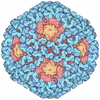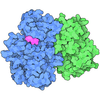+ データを開く
データを開く
- 基本情報
基本情報
| 登録情報 | データベース: PDB / ID: 8qy5 | |||||||||||||||
|---|---|---|---|---|---|---|---|---|---|---|---|---|---|---|---|---|
| タイトル | Structure of interleukin 6. | |||||||||||||||
 要素 要素 |
| |||||||||||||||
 キーワード キーワード | IMMUNE SYSTEM / interleukin / gp130 | |||||||||||||||
| 機能・相同性 |  機能・相同性情報 機能・相同性情報oncostatin-M receptor activity / ciliary neurotrophic factor binding / regulation of astrocyte activation / glucagon secretion / positive regulation of interleukin-21 production / IL-6-type cytokine receptor ligand interactions / MAPK3 (ERK1) activation / MAPK1 (ERK2) activation / Interleukin-27 signaling / leukemia inhibitory factor receptor activity ...oncostatin-M receptor activity / ciliary neurotrophic factor binding / regulation of astrocyte activation / glucagon secretion / positive regulation of interleukin-21 production / IL-6-type cytokine receptor ligand interactions / MAPK3 (ERK1) activation / MAPK1 (ERK2) activation / Interleukin-27 signaling / leukemia inhibitory factor receptor activity / regulation of glucagon secretion / hepatic immune response / interleukin-6 receptor activity / interleukin-6 binding / Interleukin-6 signaling / negative regulation of primary miRNA processing / Interleukin-35 Signalling / regulation of vascular endothelial growth factor production / negative regulation of interleukin-1-mediated signaling pathway / oncostatin-M receptor complex / interleukin-27 receptor activity / regulation of microglial cell activation / ciliary neurotrophic factor receptor binding / ciliary neurotrophic factor-mediated signaling pathway / interleukin-11 receptor activity / interleukin-11 binding / ciliary neurotrophic factor receptor complex / interleukin-6 receptor complex / positive regulation of apoptotic DNA fragmentation / hepatocyte proliferation / positive regulation of type B pancreatic cell apoptotic process / germinal center B cell differentiation / positive regulation of extracellular matrix disassembly / neutrophil apoptotic process / response to peptidoglycan / positive regulation of B cell activation / interleukin-11-mediated signaling pathway / positive regulation of receptor signaling pathway via STAT / interleukin-6 receptor binding / T-helper 17 cell lineage commitment / inflammatory response to wounding / regulation of Notch signaling pathway / positive regulation of T-helper 2 cell cytokine production / endocrine pancreas development / negative regulation of collagen biosynthetic process / regulation of neuroinflammatory response / positive regulation of acute inflammatory response / vascular endothelial growth factor production / positive regulation of adaptive immune response / positive regulation of astrocyte differentiation / negative regulation of chemokine production / T follicular helper cell differentiation / positive regulation of neuroinflammatory response / intestinal epithelial cell development / positive regulation of glomerular mesangial cell proliferation / negative regulation of interleukin-8 production / positive regulation of leukocyte chemotaxis / positive regulation of platelet aggregation / neutrophil mediated immunity / positive regulation of cytokine production involved in inflammatory response / cytokine receptor activity / cell surface receptor signaling pathway via STAT / positive regulation of leukocyte adhesion to vascular endothelial cell / negative regulation of bone resorption / CD163 mediating an anti-inflammatory response / positive regulation of peptidyl-tyrosine phosphorylation / positive regulation of immunoglobulin production / Interleukin-6 signaling / glycogen metabolic process / interleukin-6-mediated signaling pathway / MAPK3 (ERK1) activation / negative regulation of fat cell differentiation / positive regulation of Notch signaling pathway / maintenance of blood-brain barrier / MAPK1 (ERK2) activation / Interleukin-10 signaling / positive regulation of interleukin-17 production / monocyte chemotaxis / humoral immune response / protein tyrosine kinase activator activity / Transcriptional Regulation by VENTX / positive regulation of vascular endothelial growth factor production / positive regulation of interleukin-10 production / positive regulation of glial cell proliferation / negative regulation of lipid storage / positive regulation of peptidyl-serine phosphorylation / regulation of angiogenesis / cell surface receptor signaling pathway via JAK-STAT / positive regulation of osteoblast differentiation / positive regulation of epithelial to mesenchymal transition / : / coreceptor activity / positive regulation of chemokine production / extrinsic apoptotic signaling pathway / positive regulation of T cell proliferation / response to cytokine / positive regulation of smooth muscle cell proliferation / liver regeneration / regulation of insulin secretion / response to glucocorticoid 類似検索 - 分子機能 | |||||||||||||||
| 生物種 |   Homo sapiens (ヒト) Homo sapiens (ヒト) | |||||||||||||||
| 手法 | 電子顕微鏡法 / 単粒子再構成法 / クライオ電子顕微鏡法 / 解像度: 3.1 Å | |||||||||||||||
 データ登録者 データ登録者 | Gardner, S. / Bubeck, D. / Jin, Y. | |||||||||||||||
| 資金援助 |  英国, European Union, 4件 英国, European Union, 4件
| |||||||||||||||
 引用 引用 |  ジャーナル: Nat Commun / 年: 2024 ジャーナル: Nat Commun / 年: 2024タイトル: Structural insights into IL-11-mediated signalling and human IL6ST variant-associated immunodeficiency. 著者: Scott Gardner / Yibo Jin / Paul K Fyfe / Tomas B Voisin / Junel Sotolongo Bellón / Elizabeth Pohler / Jacob Piehler / Ignacio Moraga / Doryen Bubeck /   要旨: IL-11 and IL-6 activate signalling via assembly of the cell surface receptor gp130; however, it is unclear how signals are transmitted across the membrane to instruct cellular responses. Here we ...IL-11 and IL-6 activate signalling via assembly of the cell surface receptor gp130; however, it is unclear how signals are transmitted across the membrane to instruct cellular responses. Here we solve the cryoEM structure of the IL-11 receptor recognition complex to discover how differences in gp130-binding interfaces may drive signalling outcomes. We explore how mutations in the IL6ST gene encoding for gp130, which cause severe immune deficiencies in humans, impair signalling without blocking cytokine binding. We use cryoEM to solve structures of both IL-11 and IL-6 complexes with a mutant form of gp130 associated with human disease. Together with molecular dynamics simulations, we show that the disease-associated variant led to an increase in flexibility including motion within the cytokine-binding core and increased distance between extracellular domains. However, these distances are minimized as the transmembrane helix exits the membrane, suggesting a stringency in geometry for signalling and dimmer switch mode of action. #1: ジャーナル: Acta Crystallogr D Struct Biol / 年: 2019 タイトル: Macromolecular structure determination using X-rays, neutrons and electrons: recent developments in Phenix. 著者: Dorothee Liebschner / Pavel V Afonine / Matthew L Baker / Gábor Bunkóczi / Vincent B Chen / Tristan I Croll / Bradley Hintze / Li Wei Hung / Swati Jain / Airlie J McCoy / Nigel W Moriarty / ...著者: Dorothee Liebschner / Pavel V Afonine / Matthew L Baker / Gábor Bunkóczi / Vincent B Chen / Tristan I Croll / Bradley Hintze / Li Wei Hung / Swati Jain / Airlie J McCoy / Nigel W Moriarty / Robert D Oeffner / Billy K Poon / Michael G Prisant / Randy J Read / Jane S Richardson / David C Richardson / Massimo D Sammito / Oleg V Sobolev / Duncan H Stockwell / Thomas C Terwilliger / Alexandre G Urzhumtsev / Lizbeth L Videau / Christopher J Williams / Paul D Adams /    要旨: Diffraction (X-ray, neutron and electron) and electron cryo-microscopy are powerful methods to determine three-dimensional macromolecular structures, which are required to understand biological ...Diffraction (X-ray, neutron and electron) and electron cryo-microscopy are powerful methods to determine three-dimensional macromolecular structures, which are required to understand biological processes and to develop new therapeutics against diseases. The overall structure-solution workflow is similar for these techniques, but nuances exist because the properties of the reduced experimental data are different. Software tools for structure determination should therefore be tailored for each method. Phenix is a comprehensive software package for macromolecular structure determination that handles data from any of these techniques. Tasks performed with Phenix include data-quality assessment, map improvement, model building, the validation/rebuilding/refinement cycle and deposition. Each tool caters to the type of experimental data. The design of Phenix emphasizes the automation of procedures, where possible, to minimize repetitive and time-consuming manual tasks, while default parameters are chosen to encourage best practice. A graphical user interface provides access to many command-line features of Phenix and streamlines the transition between programs, project tracking and re-running of previous tasks. | |||||||||||||||
| 履歴 |
|
- 構造の表示
構造の表示
| 構造ビューア | 分子:  Molmil Molmil Jmol/JSmol Jmol/JSmol |
|---|
- ダウンロードとリンク
ダウンロードとリンク
- ダウンロード
ダウンロード
| PDBx/mmCIF形式 |  8qy5.cif.gz 8qy5.cif.gz | 901.3 KB | 表示 |  PDBx/mmCIF形式 PDBx/mmCIF形式 |
|---|---|---|---|---|
| PDB形式 |  pdb8qy5.ent.gz pdb8qy5.ent.gz | 596.8 KB | 表示 |  PDB形式 PDB形式 |
| PDBx/mmJSON形式 |  8qy5.json.gz 8qy5.json.gz | ツリー表示 |  PDBx/mmJSON形式 PDBx/mmJSON形式 | |
| その他 |  その他のダウンロード その他のダウンロード |
-検証レポート
| 文書・要旨 |  8qy5_validation.pdf.gz 8qy5_validation.pdf.gz | 1.5 MB | 表示 |  wwPDB検証レポート wwPDB検証レポート |
|---|---|---|---|---|
| 文書・詳細版 |  8qy5_full_validation.pdf.gz 8qy5_full_validation.pdf.gz | 1.5 MB | 表示 | |
| XML形式データ |  8qy5_validation.xml.gz 8qy5_validation.xml.gz | 69.4 KB | 表示 | |
| CIF形式データ |  8qy5_validation.cif.gz 8qy5_validation.cif.gz | 103.4 KB | 表示 | |
| アーカイブディレクトリ |  https://data.pdbj.org/pub/pdb/validation_reports/qy/8qy5 https://data.pdbj.org/pub/pdb/validation_reports/qy/8qy5 ftp://data.pdbj.org/pub/pdb/validation_reports/qy/8qy5 ftp://data.pdbj.org/pub/pdb/validation_reports/qy/8qy5 | HTTPS FTP |
-関連構造データ
| 関連構造データ |  18742MC  8qy4C  8qy6C M: このデータのモデリングに利用したマップデータ C: 同じ文献を引用 ( |
|---|---|
| 類似構造データ | 類似検索 - 機能・相同性  F&H 検索 F&H 検索 |
- リンク
リンク
- 集合体
集合体
| 登録構造単位 | 
| ||||||||||||||||||||||||||||||||||||||||||||||||||||||||||||||||||||||||||||||||||||||||||||||||||||||||||||||||||||||||||||||||||||
|---|---|---|---|---|---|---|---|---|---|---|---|---|---|---|---|---|---|---|---|---|---|---|---|---|---|---|---|---|---|---|---|---|---|---|---|---|---|---|---|---|---|---|---|---|---|---|---|---|---|---|---|---|---|---|---|---|---|---|---|---|---|---|---|---|---|---|---|---|---|---|---|---|---|---|---|---|---|---|---|---|---|---|---|---|---|---|---|---|---|---|---|---|---|---|---|---|---|---|---|---|---|---|---|---|---|---|---|---|---|---|---|---|---|---|---|---|---|---|---|---|---|---|---|---|---|---|---|---|---|---|---|---|---|
| 1 |
| ||||||||||||||||||||||||||||||||||||||||||||||||||||||||||||||||||||||||||||||||||||||||||||||||||||||||||||||||||||||||||||||||||||
| 非結晶学的対称性 (NCS) | NCSドメイン:
NCSドメイン領域:
|
 ムービー
ムービー コントローラー
コントローラー





 PDBj
PDBj
























